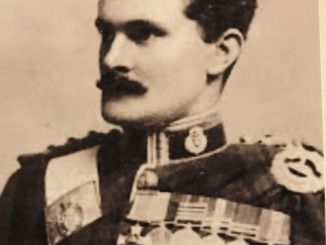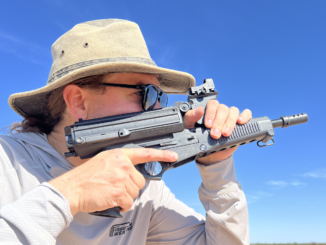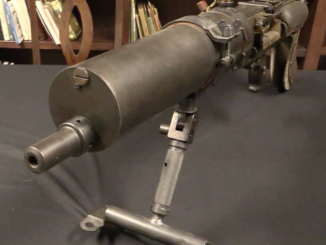On the eve of World War One, the Royal Horse Artillery and Royal Flying Corps had both adopted the Webley Self-Loading Pistol, chambered for a special .455 caliber semi-rimmed cartridge. With the needs of wartime, Webley deliveries of these pistols were too slow, and alternatives were sought. The obvious choice was the Colt 1911 pistol, already in service elsewhere with British troops. Colt had no trouble adapting the design to the .455 Webley semiauto cartridge, and between 1915 and 1919 some 13,000 of them were sold to Britain (plus more in .45 ACP). The .455 caliber guns are so marked on the slide, and all have W-prefix serial numbers to indicate their chambering. Purchases continued after the Royal Flying Corps was renamed the Royal Air Force in April 1918. While some were surplussed after the war, others would stay in service until World War Two.
Related Articles

Commentary
Captain Fraser’s Webley-Fosbery: WWI in Microcosm
Captain Percy Fraser, DSO was born on January 22, 1879 and died in Ypres on the night of February 23, 1915 while attempting to aid men wounded outside their trench. His unit of the Queen’s […]

Conversion
Evolving the Cheek Pistol Concept: Calico M950
I have found the “cheek pistol” concept form Rhett Neumayer at Demonstrated Concepts to be pretty interesting. When I was thinking about what pistol designs might be suitable for this sort of use, the Calico […]

Heavy MGs
Vickers for Interwar Tanks: The Class C/T Machine Gun
The Vickers company developed several versions of the Vickers machine gun for aircraft use during the 1920s and 1930s, but they also worked on armored vehicle versions of the gun in the 1930s. Between 1930 […]

I don’t want to look down the barrel. Unlike the revolver, one cannot tell if the user is bluffing with an empty gun unless the slide is locked open. Considering that the intended user has probably trained a lot on using his side-arm, don’t bluff him with the far fetched possibility that he has no bullets left. I could be wrong.
You often end your posts by saying that you could be wrong.
You are a pretty smart guy and are hardly ever wrong.
It’s an interesting study in how humility and knowledge can go well together.
Well, I’ve made plenty of errors in my time. I learned from those errors. I’ll probably mess up plenty in the future too. That’s one trend that will never change.
Actually it undercuts his generally excellent points. Confidence is an ornament in the competent.
A bit miss.
Under normal lighting, even at 9mm, you can clearly see whether the cartridge is in the barrel or not.
A few photos.
http://www.pakguns.com/showthread.php?14890-Colt-1911-in-455-Webley-Auto
Let’s try to get this straight. At 9 meters (not 9 millimeters), is it possible to tell if a semiautomatic handgun has a loaded chamber by staring right down the barrel with the usual light source (namely, the Sun) being high overhead and the gun pointed horizontally at the viewer? Or are is it possible to call a bluff made by someone who is using an empty revolver at a distance of 9 meters away from the viewer?
Of course.
From a distance or with the wrong location of the light source, nothing can be understood.
But usually, at a short distance, either the reflection from the bullet or the slide mirror with the firing pin hole can be seen quite well.
It doesn’t matter if the weapon is loaded or not.
It doesn’t even matter if it’s a toy weapon that looks like a real one.
The aiming of a weapon at a person can certainly be considered an attempted murder.
With appropriate responsive behavior.
Agreed. I’ve seen both with the right light.
You going to bet your life on it?
These were used as sidearms of sailors in Maclean’s South By Java Head, which I reread recently, and frankly, is crying for someone to make a movie adaptation.
CHUCK HARDIN – Yes I agree. Being smug and superior is part of the human condition, we will just have to try and ignore it
My Grandfather Fuller brought one back after the First World War, he went to Canada in September 1914 and joined a Highland Regiment as a Piper ( He had been a professional musician before the War) and transferred to the RFC in late 1916 after getting out of the hospital, where he met my Grandmother.
“If I had been two inches taller I would never have survived”
It was stolen some time after he died at age 87.